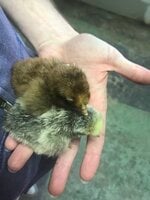To set the tableau for my confusion let me begin by saying that I obtained a pair of Silver-laced Orpington chickens. They aren't perfect by any means as their leg, beak, and I suspect skin color as well is incorrect (yellow instead of white) and the rooster has side sprigs. However size and lacing is quite good and as they were the first I'd seen I got them and am breeding them. I've obtained a pullet from another breeder but her legs are dark/slate. Anyway that's beside the point.
With the original pair I set six eggs, all six developed, and five hatched. I was very pleased with their fertility and the chicks all looked like their parents (down to the wrong leg color). A set a second batch of three eggs and hatched three chicks but one of them is clearly Gold-laced rather than Silver and seems to have willow-colored legs to boot. That means the rooster is visually (phenotype) Silver-laced but split to Gold-laced, right? Hens can only be Gold or Silver-laced so she can't be split if I understand.
Now as they are producing Gold-laced chicks does that indicate whether the chick is male or female? Like can they only produce Gold-laced cockerels? And is that cockerel visually Gold but split Silver?
Secondary set of questions:
It is my hope to create Silver-laced Blue, Splash, and Lavender Orpingtons. By crossing a SLO rooster over Blue or Splash hens I'd be introducing the blue gene. For that purpose I'd probably use Splash hens. Same with the Lavenders. What can I expect lacing to look like in the F1 generation? Does crossing the F1 generation of pullets back to their father solidify the lacing? I guess walk me through the best practice for developing these birds. Keep in mind I am very unfamiliar with the names of the genes themselves and if loci and things come up I'll get really confused really quickly. So if we can keep it as simple as we can that would be great. Like I understand Mendel and his peas and Punnet Squares...lol
@The Moonshiner
@nicalandia
@AMERAUCANAS4REAL




With the original pair I set six eggs, all six developed, and five hatched. I was very pleased with their fertility and the chicks all looked like their parents (down to the wrong leg color). A set a second batch of three eggs and hatched three chicks but one of them is clearly Gold-laced rather than Silver and seems to have willow-colored legs to boot. That means the rooster is visually (phenotype) Silver-laced but split to Gold-laced, right? Hens can only be Gold or Silver-laced so she can't be split if I understand.
Now as they are producing Gold-laced chicks does that indicate whether the chick is male or female? Like can they only produce Gold-laced cockerels? And is that cockerel visually Gold but split Silver?
Secondary set of questions:
It is my hope to create Silver-laced Blue, Splash, and Lavender Orpingtons. By crossing a SLO rooster over Blue or Splash hens I'd be introducing the blue gene. For that purpose I'd probably use Splash hens. Same with the Lavenders. What can I expect lacing to look like in the F1 generation? Does crossing the F1 generation of pullets back to their father solidify the lacing? I guess walk me through the best practice for developing these birds. Keep in mind I am very unfamiliar with the names of the genes themselves and if loci and things come up I'll get really confused really quickly. So if we can keep it as simple as we can that would be great. Like I understand Mendel and his peas and Punnet Squares...lol
@The Moonshiner
@nicalandia
@AMERAUCANAS4REAL




